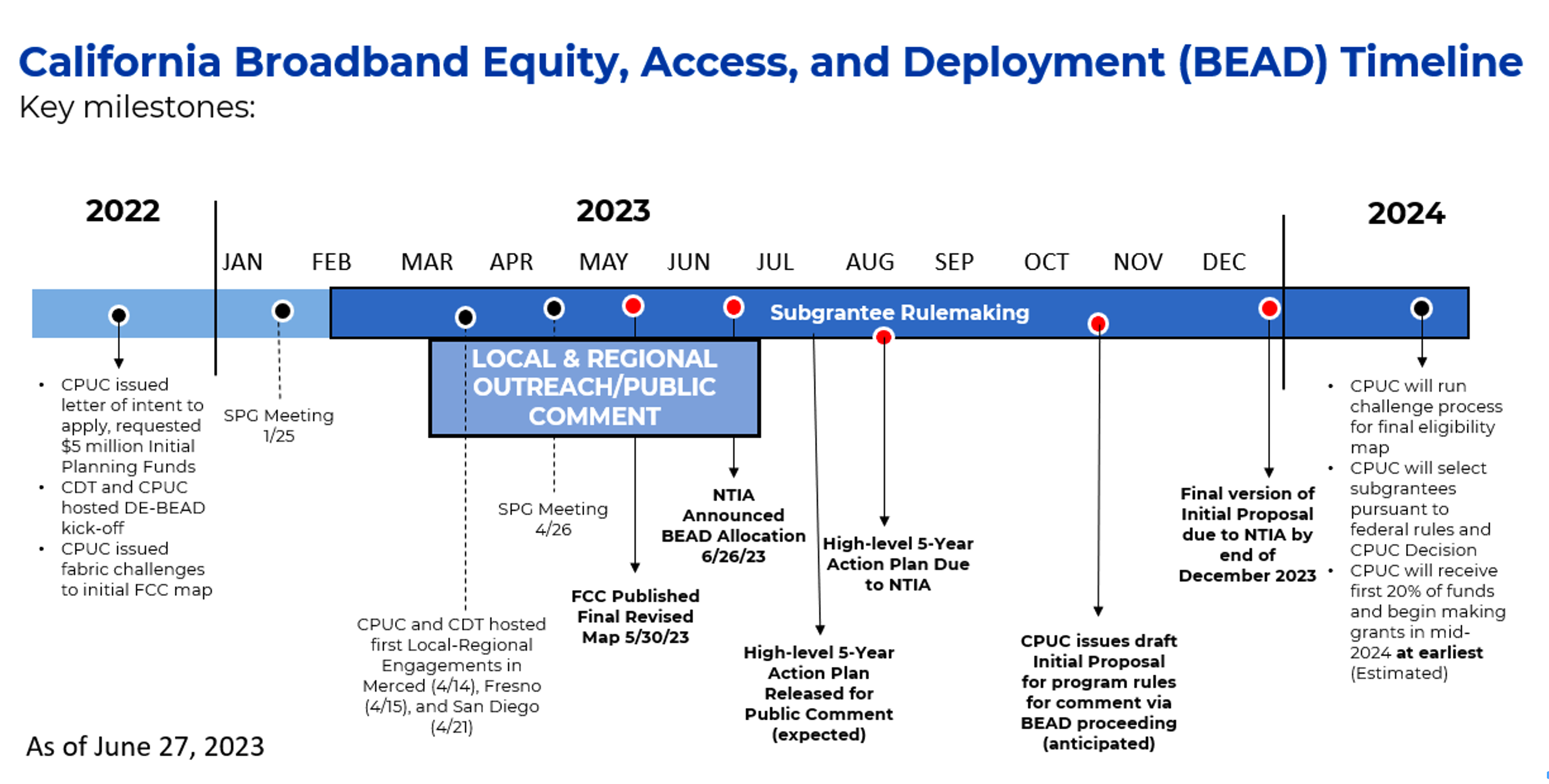Broadband Equity Access and Deployment Program (BEAD)
by Leo Vegoda
Innovators and early adopters had telephones in the late 19th century but it took a century for everyone to have access. The internet’s rollout has been faster. But even in California, eight percent of households do not have access or a device to use it. That grows to 19 percent in Mississippi and New Mexico.
Households without reliable internet access are cut off from commerce, education, government services, and healthcare. Communities without good internet experience all this and lose people to better connected places. It’s a downward spiral.
That’s why the US government has allocated $42 billion to grow high-speed internet access across the country. Its Broadband Equity Access and Deployment (BEAD) program is open to every state and six territories.
The states and the territories will be making grants from their allocated funds. The states can make initial proposals for how to spend the money until the end of 2023.
BEAD is designed to deliver high-speed internet access to areas without service. Grants can be awarded for upgrades to existing networks and new builds. In some cases, electrical coops will use their existing network to deliver internet access.
Grants are on offer to fill the gaps the market has missed. Because they are grants and not loans, the providers should be able to provide much more affordable service. The initiative comes with subsidies for low-income households to ensure this.
When everyone has internet devices and access they can become digitally literate. BEAD emphasizes the importance of projects to expand learning and development approaches that meet the needs of the targeted communities. This is important because BEAD grants are intended to bring people together and reinvigorate communities.
The US government hopes BEAD will be transformational. Giving communities reliable, high-speed internet does more than increase their access, it makes the communities themselves more accessible to the world at large. It will give businesses and schools new opportunities. It will also improve healthcare in places where it can take professional hours or days to reach patients.
Compare with California
Decentralized government means that processes will differ. But the BEAD program provides a guiding framework so, many states will have a similar approach. It’s worth examining California’s plans for spending the money.
California’s Public Utilities Commission is running its implementation. Their application process will start next year. The application window could open early in 2024 with the first fifth of grants being awarded from June.

California’s BEAD Program implementation timeline, with grantmaking starting in mid-2024.
Key Questions and Assistance
Look at the table below to find out how much money your state or territory has been allocated. Then look for the answers to these three questions:
- Which government department is handling applications?
- When will their process be open to applications?
- What are the qualifying criteria for the kind of grant you want?
We run the world’s most trusted IPv4 marketplace, so we have unique experience from all sorts of networks. We help you get the IPv4 addresses you’ll need for your project and we can connect you with engineering talent you need. We’ll get you started on your journey to a grant award.
Call us on (212) 610 5601 or write to us at info@ipv4.global.
Allocation per State or Territory
| State | Amount Allocated |
| Alabama | $1.4 billion |
| Alaska | $1 billion |
| Arizona | $1 billion |
| Arkansas | $1 billion |
| California | $1.8 billion |
| Colorado | $826 million |
| Connecticut | $144 million |
| Delaware | $107 million |
| District of Columbia | $101 million |
| Florida | $1.2 billion |
| Georgia | $1.3 billion |
| Hawaii | $149 million |
| Idaho | $583 million |
| Illinois | $1 billion |
| Indiana | $868 million |
| Iowa | $415 million |
| Kansas | $452 million |
| Kentucky | $1 billion |
| Louisiana | $1.3 billion |
| Maine | $272 million |
| Maryland | $268 million |
| Massachusetts | $147 million |
| Michigan | $1.5 billion |
| Minnesota | $652 million |
| Mississippi | $1.2 billion |
| Missouri | $1.7 billion |
| Montana | $629 million |
| Nebraska | $405 million |
| Nevada | $417 million |
| New Hampshire | $197 million |
| New Jersey | $264 illion |
| New Mexico | $675 million |
| New York | $665 million |
| North Carolina | $1.5 billion |
| North Dakota | $130 million |
| Ohio | $794 million |
| Oklahoma | $797 million |
| Oregon | $689 million |
| Pennsylvania | $1.2 billion |
| Rhode Island | $109 million |
| South Carolina | $552 million |
| South Dakota | $207 million |
| Tennessee | $813 million |
| Texas | $3.3 billion |
| Utah | $317 million |
| Vermont | $229 million |
| Virginia | $1.4 billion |
| Washington | $1.2 billion |
| West Virginia | $1.2 billion |
| Wisconsin | $1 billion |
| Wyoming | $347 million |
| American Samoa | $38 million |
| Guam | $157 million |
| Northern Mariana Islands | $81 million |
| Puerto Rico | $335 million |
| U.S. Virgin Islands | $27 million |